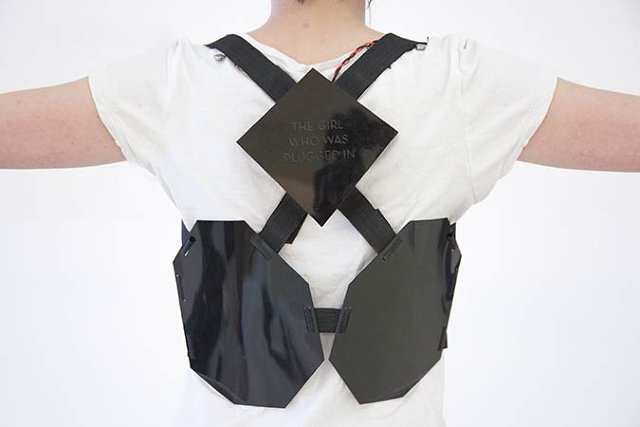Have you ever felt your pulse quicken when you read a book, or your skin go clammy during a horror story? A new student project out of MIT wants to deepen those sensations. They have created a wearable book that uses inexpensive technology and neuroscientific hacking to create a sort of cyberpunk Neverending Story that blurs the line between the bodies of a reader and protagonist.
Called Sensory Fiction, the project was created by a team of four MIT students--Felix Heibeck, Alexis Hope, Julie Legault, and Sophia Brueckner--who took part in Science Fiction To Science Fabrication class, a multimedia course that uses sci-fi as both inspiration and caution for the technology of the future.
"I like to say that science fiction is like ethics for inventors," Brueckner tells Co.Design. "Science fiction authors take notice of current trends in technology and extrapolate them into the future, warning us to be thoughtful about what we build. Though often cautionary, this zoomed out way of thinking can be optimistic too. What can we build today that can effect positive changes in the far future? Subtle design choices can make an enormous difference!"
Sensory Fiction was inspired by two sci-fi visions of what media in the future will look like. The first is Neil Stephenson's steampunk classic, The Diamond Age, a novel that features interactive books with built in AIs. (The book that is often seen as the fictional inspiration for many of today's technologies, like the iPad and Siri.) The other is The Girl Who Was Plugged In, a 1974 novella by James Tiptree, Jr. about a future in which the desperate are allowed to pay to take over the bodies of attractive human vessels.

"You feel this story in your gut," Hope says about The Girl Who Was Plugged In. "It is an amazing example of the power of fiction to make us feel and empathize with a protagonist. Because our imaginations and emotions were so strongly moved by this story, we wondered how we could heighten the experience."
The Sensory Fiction prototype is a vest that plugs into a computerized copy of Tiptree's novella. Controlled by an Arduino microprocessor, the vest swells, contracts, vibrates, heats up or cools down as the pages of the book are turned. As the protagonist of the story comes into conflict, the vest mirrors her physical or emotional changes in the reader. A particularly sad page might cause the vest's in-built air bags to expand, rendering the reader tight chested; when the plot heats up, the vest might make a reader sweat.

"The whole point of books is to feed on that empathy that is created when we experience a narrative with a dramatic arc," explains Legault. "It floods our brains with oxytocin and allows us to empathize with the protagonists."
Some writers who consider literature's power to ultimately reside in the ability to trigger physical and emotional changes in a reader with words alone might consider it cheating, but what the Sensory Fiction team at MIT have highlighted is that readers already plug themselves into the minds and bodies of fictional characters every time they open a book. All Sensory Fiction does is put a wearable device at one end of the pipe.

Perhaps it works a little too well at making readers feel what the heroes of their favorite stories feel, though. According to Heibeck, the circuit board on the Sensory Fiction prototype didn't survive many readings before it overloaded and burned out.
You can find more information about MIT's Science Fiction To Science Fabrication class here.